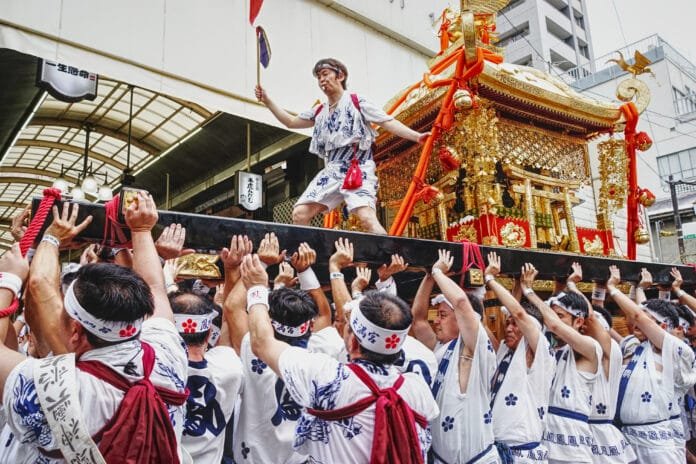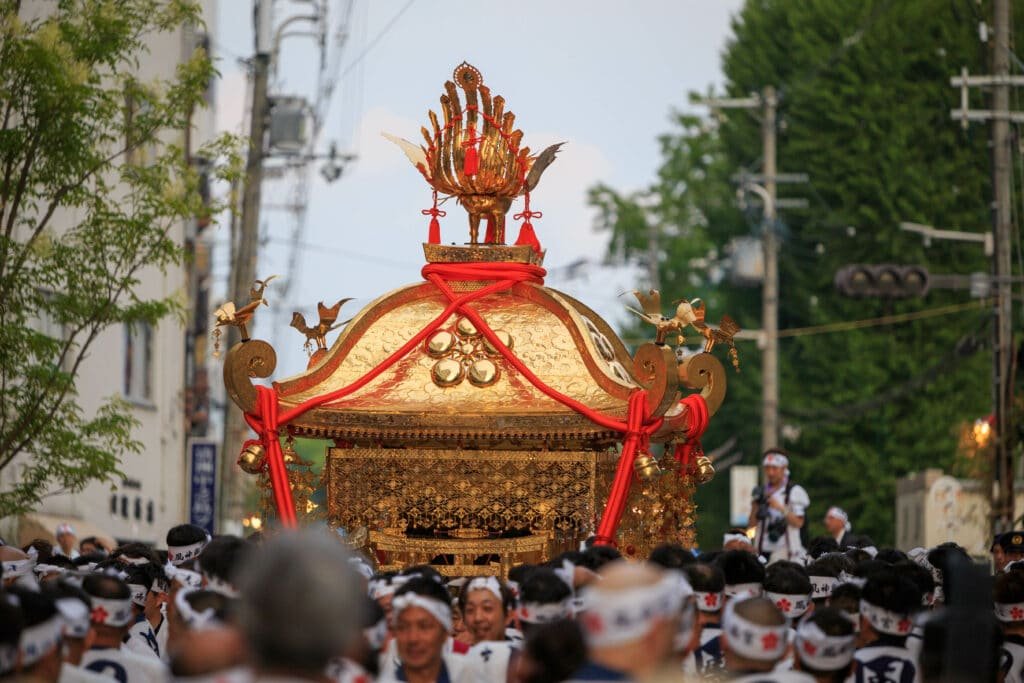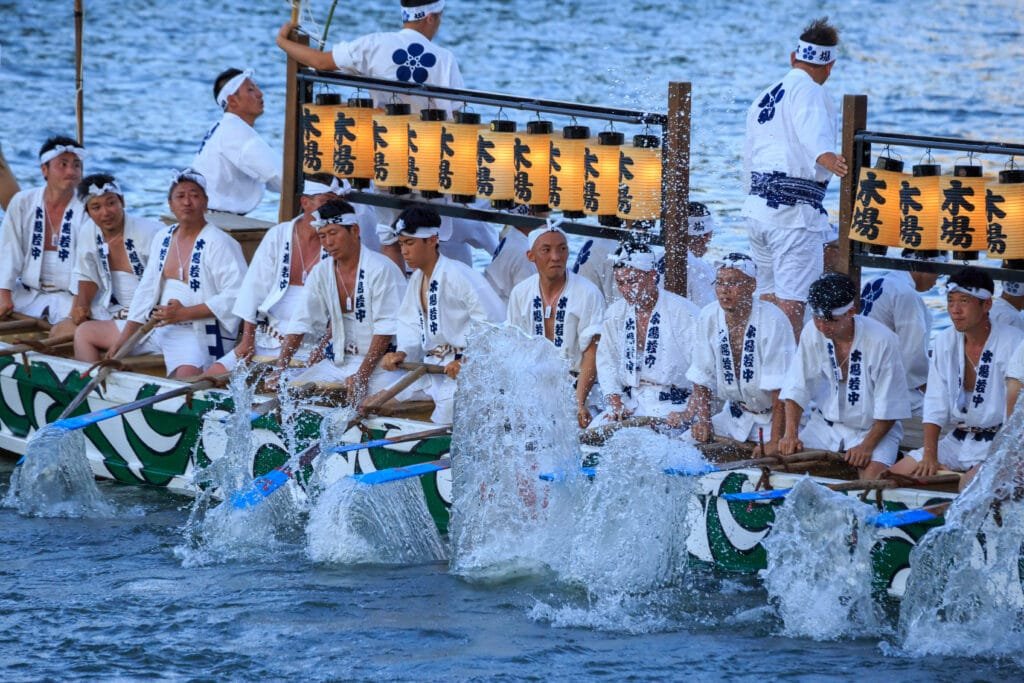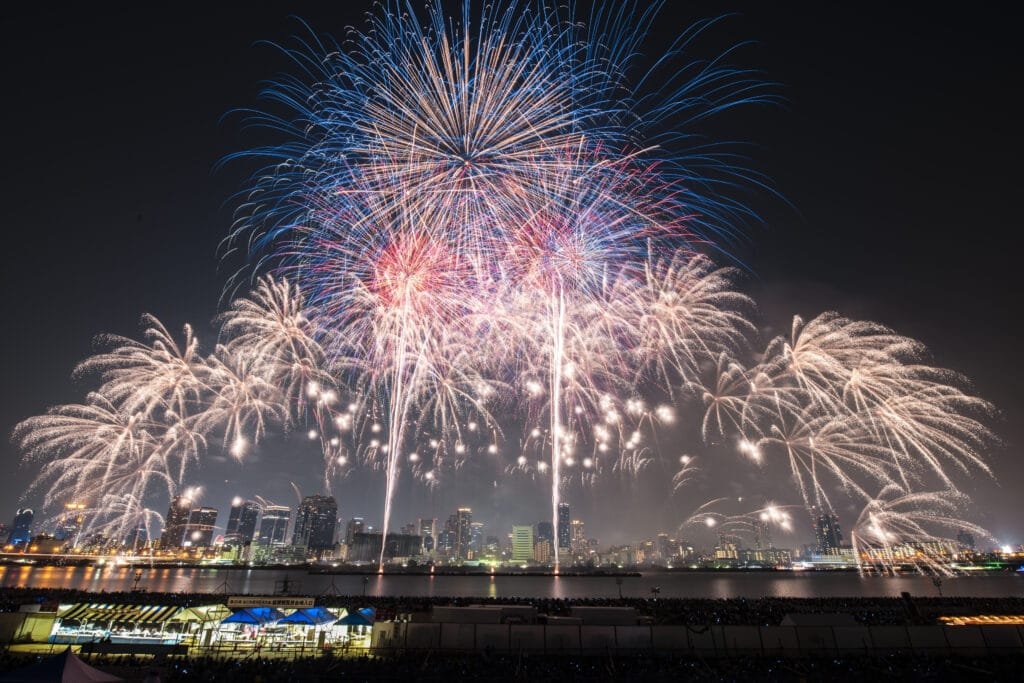
Table of Contents
What is Tenjin Matsuri Festival?
Tenjin Matsuri is also called the festival of fire and water. It combines the elements throughout its procession. It is amongst one of the largest events in the whole of Japan. The festival lasts for one month and takes place every year, culminating on July 24th and finishes on the 25th. On the day of the 24th, there is a Hokonagashi-Shinji ritual to pray for the people of Osaka’s health, security, and happiness. The festival climaxes on the 25th, with a 100 boat parade down the Okawa River. Finally, it is then capped off with one of Japan’s most spectacular fireworks displays.
History of Tenjin Matsuri Festival
The festival dates back to over 1000 years ago. It started in 951 to commemorate the Shinto God of Learning, Suagawara no Michizane, at Tenmangu shrine. On one special day during the Tenryaku Era (951), a halberd from the gods washed up on the beach at the head of the shrine. People thought that this halberd was from God Michizane. This sacred spot is a holy resting place, called otabisho. The ceremony of Michizane’s death was his divine spirit escorted to the otabisho by boat. This was the beginning of the Tenjin Matsuri.
July 24th – Yomiya
On the morning of the 24th at 7:45 am, the ritual starts at the Tenmangu shrine. Alongside this, there is a Taiko-Japanese drum performance. Next, a Danjiri (Omikoshi carrier) dancer as well as a dragon dance to signify the start of this festival. A procession of 200 child prodigies and servants of the leave from the shrine and head towards the Wakamatsucho funeral hall. Next to the Hokonagashi bridge, at 9:00 am, the shrine’s maidens perform a special ritual. This is called “minadzukiharae”. Next, a small ceremony involved the Shindo (wonder child), shinshoku (Shinto priest), and gakujin (musician). These three float out on the Okawa river by a small boat and throw a sacred plain wood kamihoko into the river. This resembles the halberd that appeared on the beach, in 951.

July 25th – Honmiya
Rikutogyo
At 3:30 pm, a group of 3,000 people, dressed in colored costumes, leave the Tenmangu shrine. They make their way towards the start of the funatogyo, approximately 4km away. The head of the procession is the moyoshidaiko. Six drummers in a bank of 3 lines, beat to the taiko drum, whilst shouting. As if it couldn’t get more eccentric, the taiko platform sways up and down, making it a sight worth not missing. Furthermore, a host of other impressive and decorative displays are available to watch. Dashi (processional floats), mikoshi (portable shrines), and kago (sedan chairs) take part. Children and festival maids dressed in eccentric costumes are also involved. People of all ages dress up in yukatas, kimonos, and special costumes to get involved.
The streets of Osaka stop and listen to the sound of the drums and shrieks of the people. Finally, the Rikutogyo ends at around 5:30 pm, as the procession arrives at the Tenjin Bridge.
Funatogyo
The participants of the moyoshidaiko board boats and row onto the Okawa River. Four different boats take part, all for different purposes. The first is the “Gohoren Hoansen”, which carries the spirit of Michizane. Next is a “Gubusen”, which carries the drums. The “Omukaebune”, which hosts colorful dolls and puppets to welcome the divine spirit. Finally, the “Hohaisen”, which is from the companies and organizations. In addition, “dondoko” and “rakugo” boats line the banks to further enhance the festivals’ atmosphere. These boats tell individual stories from Japan’s history and mythology.

The boats proceed up Okawa River towards Tenjin Bridge up to Miyakoshima Bridge. As boats pass each other, people shout “打ーちましょ” (Clap your hands!). it’s followed by “もひとつせー” (One more time!) and again “祝うて三度” (a third time!).
Fireworks
At 19:30, as the sun sets, the finale of the Tenjin Matsuri festival begins. Thousands of people flock to the banks of the Okawa river to watch the mesmerizing fireworks display. Around 5,000 fireworks launch into the sky, all taking various shapes and colors. The most notable is the “red plum” fireworks, which represent the original shape of the festival. In addition, various character-shaped fireworks and gimmicks are also viewable.

Tenjin Matsuri 2022
“It is premised that no priority measures such as spread prevention or a state of emergency have been issued in Osaka Prefecture, and there is no request to refrain from going out. Therefore, if the situation changes near or before the day of the festival and the corona infection situation is expected to worsen, there is no service for the lecture, and it is possible that the sacred spirit will be handed over only at Osaka Tenmangu Shrine.”
1 Perform “Shinto ritual” by a method that conforms to the previous format.
2 “Rikutogo” will be implemented with a formal route (the first year of Reiwa), but the content will be planned with due consideration of infectious disease prevention and countermeasures, and drastic changes in the number of ministers and ongoing practices. do. Of the schedule, the events will end around 19:00 at sunset.
3 “Funatogyo” will not be implemented.
4 “Fireworks” will not be held.
The schedule for 2021 Tenjin Matsuri is as follows:
July 24
Evening Palace Festival (Main Hall)
Hokonagare Shinto (formerly in front of Wakamatsuhama Tenma Police Station)
Gyomiya Evening Palace Festival (Chiyozaki, Nishi-ku)
July 25
Honden Festival (Main Hall)
Shinto Relocation Onogi (Main Hall) Rikuto Gojo Festival (Honden Festival-Tenjinbashi Kitazume Riverside) Return Festival (Main Hall)
Gyomiya Honden Festival (Chiyozaki, Nishi-ku)
Where to enjoy Tenjin Matsuri
Tenmangu Shrine
On the 24th of July, you can visit Tenmangu shrine early in the morning. The beginnings of the festival start there so you can follow it throughout the day.
Web: https://osakatemmangu.or.jp/
Phone: 06-6353-0025
Address: 2 Chome-1-8 Tenjinbashi, Kita Ward, Osaka, 530-0041
Okawa River
Funatogyo takes place at Okawa River, so if you can find empty spots along the banks, I would highly recommend it. It is usually extremely busy as over 1.3million people meet up to see the festival. However, if you manage to find an empty spot, you will have the best spot in all of Osaka. Try to arrive in advance as it will get extremely crowded and hard to walk around.
Along the banks of the rivers, you will find plenty of food stalls and gift shops. Merchants sell traditional Osaka food such as Takoyaki or Yaki soba so it’s a great place to try some of Osaka’s cuisine.
The first spot I recommend trying is next to Osaka Imperial Hotel. Here, you get a fantastic view of the funatogyo procession and the fireworks display! Furthermore, this might also be a great place to stay overnight, but please book in advance!
Web: https://www.imperialhotel.co.jp
Phone: 06-6881-1111
Address: 1 Chome-8-50 Tenmabashi, Kita Ward, Osaka, 530-0042
Some other great spots include the OAP Tower & Plaza or Miyakojima Bridge. There will be significantly fewer people but you may not be able to see the funatogyo procession.
Spectator Seats
If you worry about getting a good spot, there is a dedicated viewing area to buy seats. Tables and chairs are available on the banks of the river for people to purchase. You can get seats around Sakuranomiya or Tenman Bridge. These two spots offer great views of the funatogyo and fireworks! If you want to view more, you can visit the website here.
Tenjin Matsuri steeps in history and is one of the most spectacular events in all of Japan. Watching the whole of Osaka unite together is the best Japanese experience to make your trip even more memorable. Enjoy the fireworks and the amazing food, all while dressed up in a beautiful yukata. There’s no better way to experience Osaka than Tenjin Matsuri.



















[…] Tenjin Festival, one of Japan’s three major festivals, pays tribute to Sugawara no Michizane, the deity of […]